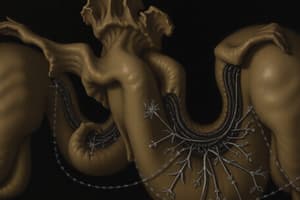Podcast
Questions and Answers
What is the primary hormone produced by the parathyroid glands?
What is the primary hormone produced by the parathyroid glands?
- Vitamin D
- Osteocalcin
- Parathyroid hormone (PTH) (correct)
- Calcitonin
What triggers the release of parathyroid hormone (PTH)?
What triggers the release of parathyroid hormone (PTH)?
- High phosphate levels
- High blood calcium levels
- Low vitamin D levels
- Low blood calcium levels (correct)
Which of the following is a direct effect of parathyroid hormone (PTH)?
Which of the following is a direct effect of parathyroid hormone (PTH)?
- Increases bone mineral density
- Stimulates osteoclasts to increase bone resorption (correct)
- Decreases intestinal calcium absorption
- Stimulates calcium excretion in urine
What is the synergistic effect of calcitriol in relation to PTH?
What is the synergistic effect of calcitriol in relation to PTH?
What condition results from excessive secretion of parathyroid hormone (PTH)?
What condition results from excessive secretion of parathyroid hormone (PTH)?
How does PTH affect the kidneys specifically?
How does PTH affect the kidneys specifically?
Which serum calcium levels are considered normal?
Which serum calcium levels are considered normal?
What might be a symptom of hypoparathyroidism?
What might be a symptom of hypoparathyroidism?
What treatment is commonly used for hypoparathyroidism?
What treatment is commonly used for hypoparathyroidism?
Which of the following laboratory tests is used to assess parathyroid function?
Which of the following laboratory tests is used to assess parathyroid function?
Flashcards are hidden until you start studying
Study Notes
Parathyroid and Calcium Regulation
-
Location and Structure
- Four small glands located on the posterior aspect of the thyroid gland.
- Each gland is about the size of a grain of rice.
-
Function of Parathyroid Glands
- Produce parathyroid hormone (PTH), which regulates calcium levels in the blood.
-
Calcium Regulation Mechanism
-
PTH Release
- Stimulated by low blood calcium levels (hypocalcemia).
-
Effects of PTH
- Bone Resorption
- Stimulates osteoclasts to break down bone, releasing calcium into the bloodstream.
- Kidney Function
- Increases renal tubular reabsorption of calcium and decreases phosphate reabsorption.
- Stimulates conversion of vitamin D to its active form (calcitriol), enhancing calcium absorption in the intestines.
- Intestinal Absorption
- Active vitamin D (calcitriol) increases calcium absorption from dietary sources.
- Bone Resorption
-
-
Calcium Homeostasis
- Normal blood calcium levels range from 8.5 to 10.2 mg/dL.
- PTH, along with calcitonin (produced by the thyroid gland), maintains calcium levels:
- Calcitriol has a synergistic effect with PTH on calcium absorption.
-
Pathophysiology
- Hyperparathyroidism
- Excessive PTH secretion leading to elevated calcium levels (hypercalcemia), bone loss, and kidney stones.
- Hypoparathyroidism
- Insufficient PTH secretion leading to low calcium levels (hypocalcemia), muscle cramps, and potential seizures.
- Hyperparathyroidism
-
Clinical Relevance
- Diagnosis
- Measured through serum calcium and PTH levels to assess parathyroid function.
- Treatment
- Calcium and vitamin D supplementation for hypoparathyroidism.
- Surgical removal or management of hyperparathyroidism.
- Diagnosis
Parathyroid Glands
- Small, pea-sized glands located behind the thyroid gland
- Produce parathyroid hormone (PTH)
Calcium Regulation: The Role of PTH
- PTH is released when blood calcium levels are low (hypocalcemia)
- PTH's Actions:
- Bone: Stimulates bone resorption by osteoclasts, releasing calcium into the blood
- Kidney: Increases calcium reabsorption and decreases phosphate reabsorption in the kidneys
- Intestine: Promotes conversion of vitamin D to its active form (calcitriol), enhancing calcium absorption
- Normal blood calcium levels: 8.5 to 10.2 mg/dL
Maintaining Calcium Homeostasis
- PTH and calcitonin (from the thyroid gland) work together to regulate calcium levels
- Calcitriol and PTH synergistically increase calcium absorption
Hyperparathyroidism
- Excess PTH secretion leads to high blood calcium levels (hypercalcemia)
- Symptoms: bone loss, kidney stones
Hypoparathyroidism
- Insufficient PTH production leads to low blood calcium levels (hypocalcemia)
- Symptoms: muscle cramps, seizures
Clinical Relevance
- Diagnosis: Blood tests measure serum calcium and PTH levels
- Treatment:
- Hypoparathyroidism: Calcium and vitamin D supplementation
- Hyperparathyroidism: Surgical removal or management of the affected gland(s)
Studying That Suits You
Use AI to generate personalized quizzes and flashcards to suit your learning preferences.




